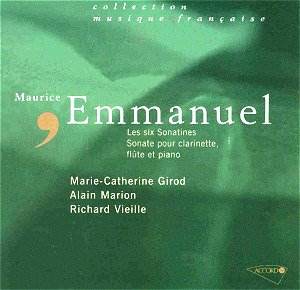Maurice Emmanuel despite
a pitilessly cruel jibe by Delibes rose
to recognition which has only just held
firm following his death just a year
short of the Second World War.
His six sonatinas were
written between the ages of 31 and 63.
They have in common a title, conciseness
and a consanguinity of language. Within
that frame there is variety. The First
is in four movements, four of them are
in three and the Alla Francese is
in six. Some of the sonatinas have evocative
titles; others have none. The individual
movements of Pastorale and Alla
Francese also have titles; the former
involving birds (La Caille, Le
Rossignol, Le Coucou - Quail,
Nightingale, Cuckoo) and
the latter the typical Bachian complement
(Ouverture, Courante,
Sarabande, Gavotte, Pavane
et Gaillarde and Gigue).
The Bach titles of No. 5 should come
as no surprise. He edited various of
Bach’s work clavier including the Partitas,
Italian Concerto and French
and English Suites. The Fifth
is dedicated to Robert Casadesus and
comprises music of cut-glass precision
but with an emotional dimension related
to Poulenc. The Fourth Hindou
is dedicated to Busoni (who also wrote
six Sonatinas). Delage, Koechlin, Schmitt,
Cras, Tomasi and Roussel amongst many
others delighted in the exotic harmonic
world of the Far East and in increasingly
impressionistic finery this work moves
in a dreamy and suggestive world becoming
menacingly assertive in the warlike
and cruel finale. It reminded me of
John Foulds’ Essays in the Modes;
itself published by Salabert in Paris
and recorded on Altarus and Bis.
I cannot imagine Girod
being bettered in this music. She is
no stranger to Emmanuel returning to
his works in 1995 for the Timpani collection
of Emmanuel songs (1C1030). That disc
included Odelettes Anacréontiques
Op. 13 (1911); Musiques Op.
17 (1918); Vocalise-Étude
Op. 24 (1926); In Memoriam Op.
11 (1908).
Girod faces some competition
from the similarly adventurous Peter
Jacobs who recorded all six on Continuum
CCD1048. However there is no coupling
in that case and from what I can recall
the golden extremes of impression are
not quite as vividly put across as they
are here. To have the Sonate en Trio
would in any event have swung the
recommendation given the excellence
of Girod’s reading.
Emmanuel’s two symphonies
have been recorded and issued on Marco
Polo 8.223507 along with his Poème
du Rhin. The First (1919) was written
to the memory of a young airman killed
in the Great War - rather like one of
Loeffler’s string quartets. The Second
(1931) is entitled Le Breton. The
Chansons Bourguignonnes du Pays de
Beaune are available on Warner Erato
0927 44656 2 (Dawn Upshaw) and on Marco
Polo (Florence Katz, mezzo; Jean-Pierre
Quenaudon, tenor; Laure Rivierre, piano;
Choeur Regional de Bourgogne/Roger Toulet
(8.223891). Perhaps we can now hope
for recordings of the two lyric tragedies,
the string quartet and the cello sonata.
Until then anyone interested
in the freshness and profusion of the
French music from the period 1890-1930
should track down this disc - the more
so at its attractive mid-range price.
Rewarding music and anything with Madame
Girod in it is going to be worth hearing.
I only wish that we heard more of her.
Rob Barnett


